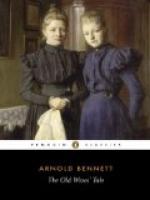Even the majestic thought that whenever and wherever in all England a woman washes up, she washes up the product of the district; that whenever and wherever in all England a plate is broken the fracture means new business for the district—even this majestic thought had probably never occurred to either of the girls. The fact is, that while in the Five Towns they were also in the Square, Bursley and the Square ignored the staple manufacture as perfectly as the district ignored the county. Bursley has the honours of antiquity in the Five Towns. No industrial development can ever rob it of its superiority in age, which makes it absolutely sure in its conceit. And the time will never come when the other towns—let them swell and bluster as they may—will not pronounce the name of Bursley as one pronounces the name of one’s mother. Add to this that the Square was the centre of Bursley’s retail trade (which scorned the staple as something wholesale, vulgar, and assuredly filthy), and you will comprehend the importance and the self-isolation of the Square in the scheme of the created universe. There you have it, embedded in the district, and the district embedded in the county, and the county lost and dreaming in the heart of England!
The Square was named after St. Luke. The Evangelist might have been startled by certain phenomena in his square, but, except in Wakes Week, when the shocking always happened, St. Luke’s Square lived in a manner passably saintly—though it contained five public-houses. It contained five public-houses, a bank, a barber’s, a confectioner’s, three grocers’, two chemists’, an ironmonger’s, a clothier’s, and five drapers’. These were all the catalogue. St. Luke’s Square had no room for minor establishments. The aristocracy of the Square undoubtedly consisted of the drapers (for the bank was impersonal); and among the five the shop of Baines stood supreme. No business establishment could possibly be more respected than that of Mr. Baines was respected. And though John Baines had been bedridden for a dozen years, he still lived on the lips of admiring, ceremonious burgesses as ’our honoured fellow-townsman.’ He deserved his reputation.




